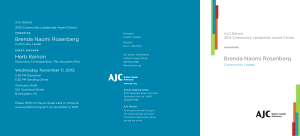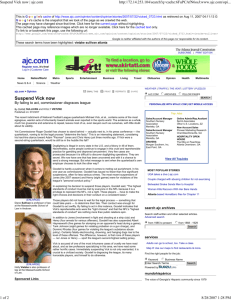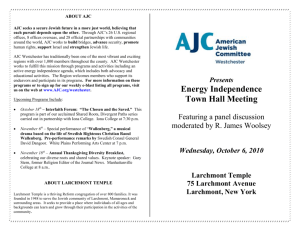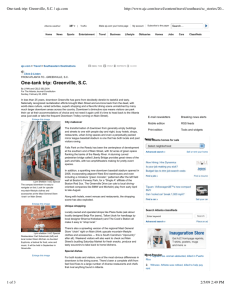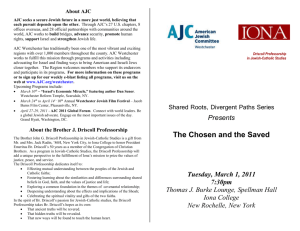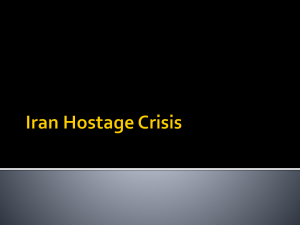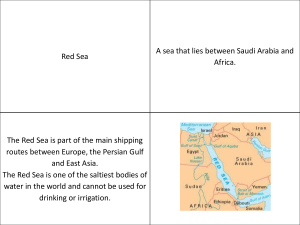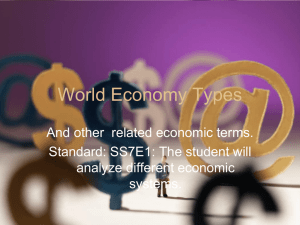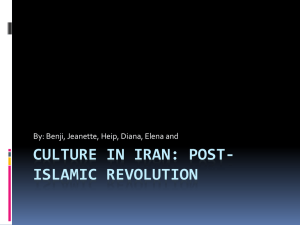How can AJC continue to play a role in advancing energy security?
advertisement
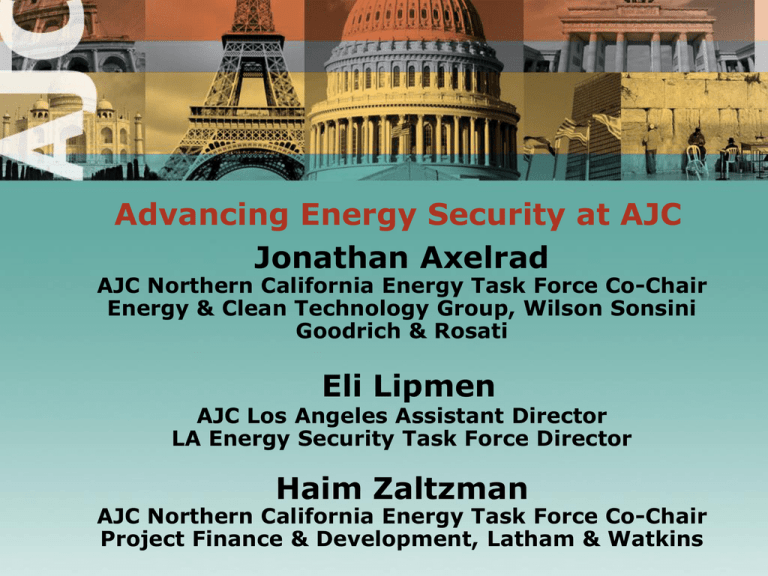
Advancing Energy Security at AJC Jonathan Axelrad AJC Northern California Energy Task Force Co-Chair Energy & Clean Technology Group, Wilson Sonsini Goodrich & Rosati Eli Lipmen AJC Los Angeles Assistant Director LA Energy Security Task Force Director Haim Zaltzman AJC Northern California Energy Task Force Co-Chair Project Finance & Development, Latham & Watkins Be courteous to others. Please remember to silence your cell phones. Road Map Section I - AJC Energy Security Successes Section II -The Energy Reality Section III - Action Plan for Advancing Energy Security Section I AJC Energy Security Success Stories National Successes - LEED Certification - Renewable Energy Credits - Project New Car - Multimedia campaign - Energy Pledge - Employee Car Program - Lobby/Support for CAFE Standards, -Open Fuel Standard & other green energy legislation AJC Regional Office Successes • • • • • • • • • • • Nationally Funded Lobbying Trips Office Practices & Employee Incentives Los Angeles Colorado New York Chicago Washington DC Westchester Atlanta Miami/Broward San Francisco AJC ACCESS Successes - J-REC: Jewish Response to the Energy Challenge - Clean Energy Mission to Germany - ACCESS New York Section II The Energy Reality: Where are we? What's the cost? What’s the opportunity? Really… How much are we talking? • How much did the US spend on imported oil in 1972? $4 billion = 1.2% of US defense budget • How much did the US spend on imported oil in 2006? $260 billion = Half US defense budget 65.5% of all oil used in US • How much is that per day? Per hour? $700 million/day; $30 million/hour Where does the oil come from? Much of the world’s largest proven oil reserves are found in unstable areas and within countries hostile to our nation’s values. Where does the oil go? How much of U.S. oil demand is driven by the transportation sector? More than 2/3rds all oil consumed in the United States goes toward transportation. Transportation Where are we going? How many trips? Transportation How are people traveling to work? Alone? Carpool? Public Transit? Who is getting the windfall? How are they spending it? “We are funding both sides of the war on terrorism” - New York Times Columnist Thomas Friedman • Guess how much a sustained $5 increase in the price of a barrel of oil correspondingly increases Iran's revenues from oil? $500 million National Security: Iran In its showdown with the West, Iran has pledged to use all means, including oil, to secure nuclear weapons. #4 Oil Exporter 9% of World Oil Reserves “If [the U.S.] makes a wrong move regarding Iran, definitely the energy flow in this region will be seriously endangered.” - Ayatollah Ali Khamenei, Iranian supreme leader “If [the U.S.] politicizes our nuclear case, we will use any means. We are rich in energy resources. We have control over the biggest and the most sensitive energy route of the world.” - Mostafa Pour-Mohammadi, Iranian minister of interior How do these petrodollars correlate to terrorist funding? How much does Iran give to Hezbollah directly every year? • Iran funds Hezbollah directly with $30 - 45 million every year. • Iranian ships were confiscated by the Israeli Navy attempting to drop off weapons to Hamas in the Gaza Strip Saudi Arabia: Oil & Wealth What is the net worth of Saudi Arabia and other OPEC oil producers at $100 per barrel? On what are some Saudis spending our money? While our petrodollars flow to Saudi Arabia, home to the world’s largest oil reserves, Saudi children are taught contempt for Christians, Jews, and the West. Excerpts from Saudi Textbooks: #1 Oil Exporter #3 US Supplier 25% of World Oil Reserves “There is no doubt that the Muslims’ power irritates the infidels and spreads envy in the hearts of the enemies of Islam – Christians, Jews, and others – so they plot against them, harass them, and seize every opportunity in order to eliminate the Muslims.” National Security: Venezuela Petrodollars fuel Hugo Chavez’s “populist” revolution at home and in neighboring countries, helping him achieve his goal of gaining influence in this Hemisphere. #5 oil exporter #4 supplier to U.S. 7% of world reserves CITGO – Venezuela’s stateowned oil company has 14,000 gas stations in U.S. “[T]he English middle classes would have to stop using their cars, [if the U.S. attacked Iran, as oil would go to $100 a barrel or more.] We would do the same if we were attacked. We would cut off our oil.” And of course - Economic Security Who's the most vulnerable to price fluctuations? United States Vulnerability Americans use more oil per person than any other country in the world. This oil dependence is estimated to create a loss of jobs, output, and tax revenues totaling between $297 - $305 billion annually. 30 25 20 Annual Per Capita 15 Barrel Oil Consumption 10 2006 5 0 India China Brazil U.K. Germany Canada* U.S. So where can we get some comfort? ELECTRIFICATION OF TRANSPORT Plug-In Electric Vehicles (PHEVs) • How much gasoline could we display if we converted all US Cars to PHEVs? • 6.5 million barrels per day or 52% of the nation's oil imports • Electricity is domestically produced – jobs/money stays in US The Future is Here…Faster, Longer, Cooler & Cheaper than you think! •Fast Acceleration, Speed •Longer Range •Cooler, Sexier Cars! Domestically Produced Power Makeup of U.S. Power Generation - (2008 approximations) Coal 50% Natural Gas 21% Nuclear 20% Hydro, Oil & Renewable 2% COMPARISON: France: 79% nuclear; Germany; 42% coal • OUR COAL DEPENDENCY 50% of U.S. states receive more than half of their electricity from coal U.S. has world’s largest coal reserves COMPARISON: China is building a coal-fired power plant every 1 - 2 weeks • WIND: U.S. surpassed Europe as world’s largest wind power producer in 2008. COMPARISON: China is third but moving quickly up. What about the cost of electricity compared to gasoline? Electricity Options versus Gasoline per Gallon • Typical power source in expensive state (NE) • 2006 Electricity price: ≅ $1.47 per gallon • Saving in other states/regions more significant • ‘Peak’ time versus ‘Non-peak’ Are we making the right investments in Electrification? Compared to China? Stimulus Spending United States • About $11 billion (out of $800 billion) China • Estimated at $220 billion (out of $580 billion Smart Grid Investment U.S. 2010 expected: $7.1 billion China 2010 expected: $7.3 billion Big Money in Clean Tech Sector • $5.6 Billion in deals in 2009 worldwide (567 companies) • Top investment areas were: • Solar (21%) • Transportation (20%) • Energy Efficiency (18%) • Biofuels (10%) • Smart Grid (7%) • By region, North America represented 72% of all deals with Europe (mainly Germany, Norway, Switzerland, Netherlands, Belgium, Denmark, UK) and Israel representing 22%, China 6% and India 3% • In North America, California had 60% of the deals ($2.1 Billion) followed in a distant second by Massachusetts with 10% ($356 million) How can AJC continue to play a role in advancing energy security? Build on Current Programs • Awards • Advocacy • Global • Domestic • Project New Car • Employee Vehicle Program • LEED Energy Security Innovator Awards • Bring attention in the Jewish community to the importance of this issue • Recognize leaders that are making an energy secure future a possibility Global Advocacy • Broader global message on energy security • Importance of fiscal, tax, or trade policy to promote clean technology • Connecting Israeli and American Cleantech companies and financiers • Incorporate green tech opportunities and alliances into AJC’s diplomatic messaging Domestic Advocacy • Short Term • Open Fuel Standard • Ensure implementation of CAFE Standards • Medium Term • Plug-In Hybrid Vehicles (PHEVs) • Project New Car/Employee Incentive Program • Long-term • Electrification of grid Take Aways/Next Steps • Group by Region (Northeast, Southeast, Central, West) • Limited Time to prepare • Appoint 1 Person to Present Conclusion New AJC Energy Security Platform

